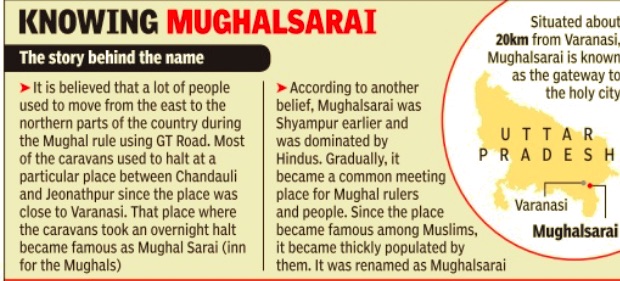Mughalsarai
This is a collection of articles archived for the excellence of their content. |
Contents |
History
See graphic :
Mughalsarai: a history

The many names of Mughalsarai
This isn't the first time Mughalsarai will be renamed. According to the records, in past centuries, it has been variously known as Mughalchak, Mangalpur and Oven Nagar. The township was named Mughalsarai when the railways established a junction here in 1883.
Located along the Grand Trunk Road, also called Sadak-e-Azam by Sher Shah Suri, Mughalsarai was one of the corridors connecting north India with the east during the Mughal period.
According to railway records, when the British started laying railway lines in this part of the country , the Patna Mughalsarai division came into existence in 1862, followed by the Mughalsarai-Allahabad division in 1864. The Mughalsarai-Varanasi-Rae Bareli and the Mughalsarai-Gaya divisions came into existence in 1898 and 1900, respectively. In Sangh's records, the name was changed to “Deen Dayal Upadhyaya Nagar“ in 1970 itself.
Many residents have questioned the logic behind renaming the station, saying Mughalsarai is known across the world because it houses Asia's biggest railway yard. “Why don't the governments think about the problems the renaming will create? People will struggle for a long time before the new name gains currency,“ said Shyamji Gupta, a trader. “If renaming is being done just because of the word `Mughal' prefixed to it, it is wrong,“ said Ramchandra, a porter at the railway station.
An ode to Mughals
What's in a name? That which we call a rose by any other name would smell as sweet,“ wrote Shakespeare. That's true, but let's say the rose was suddenly renamed Duryodhandas.Could it be associated with love as easily? Imagine the plight of a lover who wants to tell his beloved that her lips are like rose petals.
That has been the recent fate of the Mughalsarai railway junction in UP which is set to be renamed after R-S-S ideologue and Jana Sangh leader Deendayal Upadhyaya in keeping with the “sentiments of the people“. We don't know about peo ple, but the Sangh Parivar has a sentimental association with this eastern UP town. It was here that Upadhyaya's body was found lying on the tracks in 1968. Since the 1970s, the Parivar has been referring to Mughalsarai as Deendayal Upadhyaya Nagar. In 1992, the then BJP government had wanted to rename the station and township after Upadhyaya, along with Allahabad and Faizabad. But that year, the Babri Masjid was demolished and CM Kalyan Singh had to quit on “moral grounds“.
That unfinished mission has been accomplished now.But the opposition, and many people from all walks of life, have taken umbrage. On Friday, the BJP's Mukhtar Abbas Naqvi tried to shame the Opposition by saying that they have no problem with Mughal names but don't want to see the names of great thinkers -an inadvertent admission that it's the Mughal name that's problematic.
So how did Mughalsarai get its name? We don't know; there's precious little available in the archives that this correspondent dipped into.But going by its generic name and location on the Sadak-i-Azam or the Grand Trunk Road, one can assume that this must have been a busy night halt for travellers in Mughal India with several inns or serais (the largest Mughal inns had about 100odd rooms with separate suites for rich travellersnoblemen). In fact, the GT Road, which stretched from Sonargaon in today's Bangladesh to Peshawar in Pakistan, was dotted with caravanserais.
The caravanserais along with the kos minars (milestones), chaukis with harkaras and guards, rahdaris (toll gates) and cavalry patrols made imperial highways better and safer than ever before.
After the Mughals came the British. They added their own version of the serais on the Mughal routes for their own people--the dak bungalows. In the late 19th century, the British brought the railways to India, and Mughalsarai popped up on the railway map when East Indian Railway Company laid tracks connecting Howrah and Delhi. In the early 1880s, the Oudh and Rohilkhand Railway linked up with the East Indian Railway through the Dufferin Bridge (today Malviya Bridge) at Mughalsarai and the station became a junction.
As the railways united India, Mughalsarai entered the popular lexicon. Those travelling by train to the east would remember being told to eat whatever you could at Mughalsarai as “aage khaana nahin milega“ (no possibility of getting food ahead).
Today, it's the fourth-busiest station on the Indian Railways' network. To what extent would the name change affect this destiny? Not much, perhaps. But the fact that it's one of the busiest stations with 125 trains passing through it every day would make it quite a logistical exercise to change all the timetables and signage. It would also be hard to make the new name popular, just as Mumbai has struggled to replace the name VT with “Chhatrapati Shiva-ji Terminus“.
Railway station
Binay Singh, Mughalsarai station gets colour-coded, August 4, 2018: The Times of India
This railway station, situated in UP’s Chandauli district, was constructed during the British rule when the railway tracks crossed the place in 1862. With time, the station became Asia’s biggest goods train yard and one of the busiest stations of the country with the daily movement of around 250 trains.
Pandit Deen Dayal Upadhyay was found dead in mysterious circumstances near this railway station on February 24, 1968.
The Yogi cabinet passed the proposal of renaming Mughalsarai township and railway station in June 2017. The junction was formally renamed after late R-S-S ideologue Pt Deen Dayal Upadhyay at a ceremony on August 5 2018.
Ahead of the formal renaming of Mughalsarai Junction, this centuryold station of East Central Railway (ECR) that links New Delhi with Kolkata, got a quick saffron makeover..
“Software upgradation for internal and online operations, including ticket booking and finding current location of trains with the new code (DDU) [was done],” DRM Pankaj Saxena told TOI.